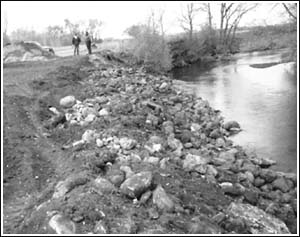

Minnesota farmers are applying conservation and environmental practices to their land at record rates.
With the financial help of Farm Service Agencies, Soil and Water Conservation Districts, and Watershed Districts, farmers are finding conservation choices more feasible.
In the North Fork Crow River Watershed (NFCRWD) District, seven different projects along the river have been or are in the process of being completed, which will help improve the water quality of Rice Lake and Lake Koronis in the future.
ďWe have a water quality program which aids landowners, providing them assistance to improve the quality of water with manure handling facilities, grass waterways, segregation of water, terraces, shoreland stablilization projects, storm water retention projects, and on-site sewage treatment systems, (septic systems) etc.,Ē Dave Kaufman, water quality technician with NFCRWD, said.
Kaufman explained the rivers have changed in so many different ways over the years. Due to flooding, and strong currents, the rivers have been getting wide and islands have formed in many areas. In many instances, the course of the river has changed due to obstructions like trees which have fallen into the river and forced the water to seek an alternative route.
In 1995 Rice Lake and Koronis Lake Diagnostic Feasibility Study identified several high priority feed lots that should be targeted for cleanup and manure management.
Among the projects under way along the North Fork Crow River from Highway 4 to Rice Lake are Eldon Hoefts and Vern Soines, both stream bank stabilization; Richard Pflueger, a manure management storage facility; Gerald Kennedy, river bank restoration; and Eugene Schultz, manure manage-ment storage facility.
The first stop on the river route, headed east from Highway 4, is the Hoeft and Soine farms. Both lost a large section of the river bank into the river.
The Soines had about 150 feet of rock riprap and filter fabric installed along the river banks to help prevent the banks from eroding into the water.
ďIn the past three to four years, we have lost about 18 feet into the river. The banks are 13 feet high,Ē Soine said. ďThat is a lot of dirt to lose into the river.Ē
The Soine project has been completed while the Hoeft project is still in the planning stages for next spring.
A mile downstream is the Richard Pflueger farm. Prior to the project, all the run-off from the feed lot, loafing shed, animal lean-to shelters, a young stock pasture area all directed toward the river. The farm buildings and feed lot setbacks from the top of the river bank range from zero to 80 feet.
The object of the project was to reduce the amount of phosphorus entering the river and ultimately Rice Lake and Lake Koronis; design and construct a manure storage pond to allow for 12 months of storage capacity; develop a nutrient management plan that will utilize the livestock manure in an efficient and environmentally sound manner and to improve the overall management of the livestock operation.
Pfluegers installed an 818,993 gallon manure storage facility, to catch all the animal waste run-off from the farm. A trough system and clean water perimeter tile was also installed to route all the run-off from the farm site into the manure pit instead of the river.
These projects were made possible with the state, federal, and private assistance of the NFCRWD, Farm Services Agency, Stearns County Soil and Water Conservation District, and Land Care Environmental Services. The design was a joint effort done by Natural Resources Conservation Service, and Central Minnesota Joint Powers Agency and Farm Service Agency.
On the west side of Paynesville, the Federal Emergency Management Agency has agreed to cover the cost of cutting out several large trees which are down in the river. ďThe trees need to be removed to prevent agitation to the river bank. The trees are blocking the flow of the water and making severe cuts into the river banks,Ē Kaufman said.
At the Gerald Kennedy farm on the north edge of Paynesville, plans are to install a riparian CRP program along the river. The river bank itself will be restored with rock riprap and bioengineering; a practice where willow and dogwood bundles are placed into the bank to re-establish vegetation. The bundles are staked to the river bank promoting natural vegetation growth.
A livestock exclusion (no cattle on the river bank) is also planned. ďWe are looking forward to restoring the river bank,Ē Mrs. Kennedy said. ďWe are planning to plant some trees and hope to restore the river bank and eliminate some of the damage cattle have done to its shore line.Ē
Downstream, closer to Rice Lake, is the Eugene Schultz farm where a manure management storage livestock facility was designed. Schultz said he had a 10- acre pond behind the barn which feeds into the river. This pond was only located 500 feet from the barn and everything from the barnyard fed into the pond.
With cold winter winds blowing, Schultz was enjoying the idea of not having to haul manure in the winter. All the manure on the farm is being routed to the 650,000 gallon lagoon which he plans on emptying once a year, probably in the fall after harvest. ďThe nutrients from the lagoon will be better for the land as they are applied more directly than left on top of the snow,Ē Schultz said. Work started on his lagoon in early June and was completed in two months.
Funds from the NFCRWD, Stearns County Soil and Water Conservation District, and Farm Service Agency helped Schultz finance his project.
All manure from these livestock operations will be stored and applied to crop land in a timely manner with a proper manure application plan. These facilities will also store feed lot run-off, eliminating it from entering surface waters.
ďAll the projects are done on a voluntary basis,Ē Kaufman said. ďWe are here to help and want to extend a big thanks to those who have worked to protect the river and the environment.Ē